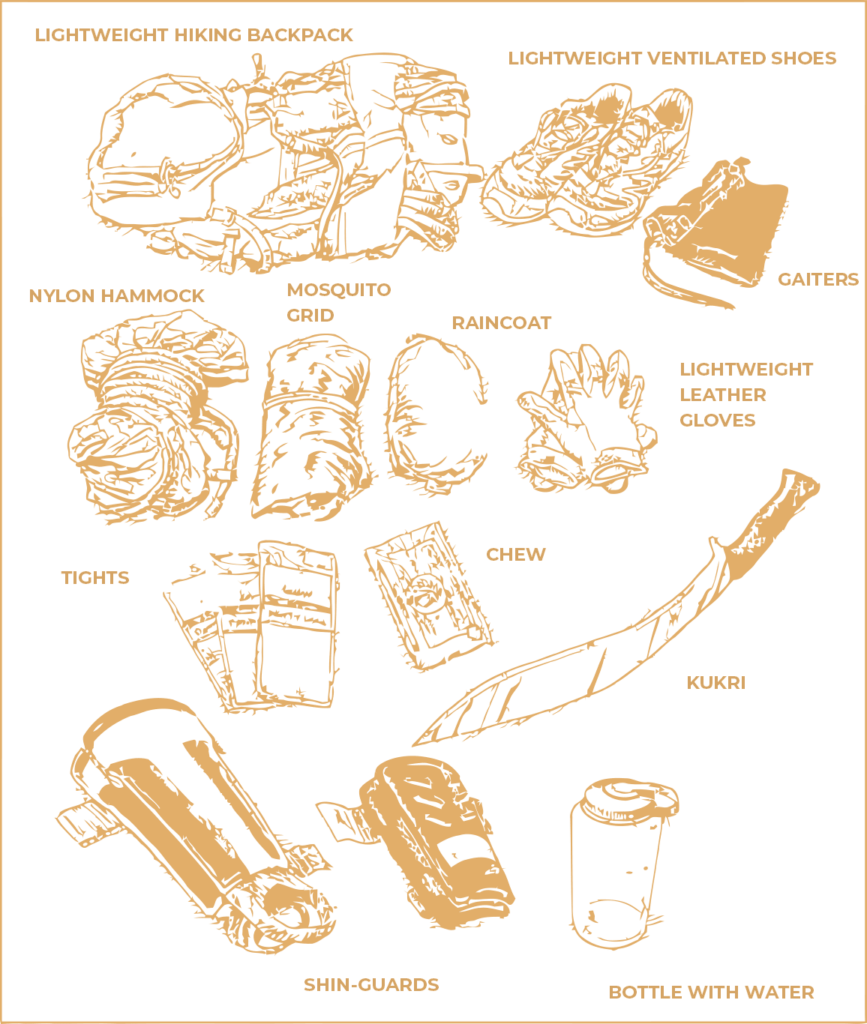WHAT TO TAKE IN THE JUNGLE
At first glance, rainforests may seem like an idyllic place. However, the jungle inhabited by life-threatening inhabitants has a specific relief, that baffles even experienced travelers. Movement at ground level often takes place in almost complete darkness. Due to the dense foliage and many vines, in the jungle twilight reigns, and most of the visible light is not reflected from the moist forest soil. In addition, at every step you have to overcome some obstacle – thorny, sticky, and sometimes poisonous plants that constantly cling to skin and clothing. It is hot and damp here, but to protect against insects and plants, you have to completely cover your body with clothes. In such conditions, a person constantly experiences discomfort.
If you are lost in the jungle, be aware that the dense vegetation around you and the harsh climatic conditions contribute to anxiety and feelings of hopelessness. Don’t give in. Keep moving. This is a prerequisite for survival.
How to work your way through the jungle
The way through the jungle is difficult for many reasons. Move along the channels of small rivers or animal paths, in this way you less often have to cut your way. For passing through dense thickets, when every step is difficult, you need a kukri – a knife with a long curved blade. With such a blade, the knife itself is quite short, and therefore it is more convenient on the road.
Strikes are applied in front of you diagonally from top to bottom.
This sturdy tool is very useful in the local area – it is used for the extraction and preparation of food, for the construction of shelter and for self-defense. Therefore, he should always be at hand. For convenience, you should carry the knife on your belt in a leather or kydex case.
The grindstone is the same mandatory accessory.
In terms of climatic and natural features, the jungle is the complete opposite of the desert, but when it comes to orientation, they have one similarity: it is easy to get lost and there and there due to the lack of topographic references. In addition, in the jungle, due to the dense crown of trees, GPS devices may not work. And the traces there may be invisible, and you risk going not forward, but in a circle. Therefore, always have a map and compass with you, and use a marker or colored tape to mark the path you have traveled. If something goes wrong, these tags will help rescuers find you.
Protection from environment
Making your way through the jungle can severely injure exposed areas of the body. To protect yourself from obstacles that get in the way, and even from your own inadvertent knife strikes when paving the road, put on shields on your forearms and shins. Forearms, shins, legs and arms are most at risk damage from shrubs and thorns. Therefore, in addition to shields, it is useful to wear a pair of light leather gloves.
Any open areas of the body are vulnerable to annoying predators living in the jungle: mosquitoes – carriers of tropical fever and the Zika virus, ants and poisonous centipedes. Insect bites can be very dangerous (even one ant bite can immobilize your arm all day long), so you need to wear the right clothes: a breathable long-sleeved shirt, pants and leggings that cover the lower limbs and prevent leeches and spiders from moving up the pants. In addition to closed clothing, other protection is needed.
For added security, wear tights under your clothes. Some can be worn on the legs, and the second, cut off at the legs and waist, close the arms to provide additional protection.
Mix water and chewing tobacco, let it stay for a few minutes, and then apply it to your hands, feet, tights, and the rest of your clothing. No matter how carefully you cover your body with clothes, blood-sucking insects will still find the way under them, but nicotine will paralyze and kill them faster than regular repellents.
A mosquito net should be a must-have item in your equipment. Throw a small piece of it over your face as you walk through the jungle, and hang the rest over where you sleep at night. You cannot leave yourself unprotected.
Always take several pairs of socks and breathable shoes. This will allow you not only to keep your feet warm and dry, but also to cope with a problem that relates not so much to comfort as to survival.

In many ways, the outcome of your stay in the jungle depends on which shoes you choose. To avoid trench feet or infectious dermatitis due to moisture or water obstacles, do not use shoes made of gortex or other airtight materials. These shoes absorb moisture, and this can lead to serious foot problems in less than a day. Without proper treatment, a trench foot can lead to gangrene and amputation. At night and whenever you stop to rest, you should take off your socks and let your feet dry. Dry wet socks on the outside of your backpack while traveling.






